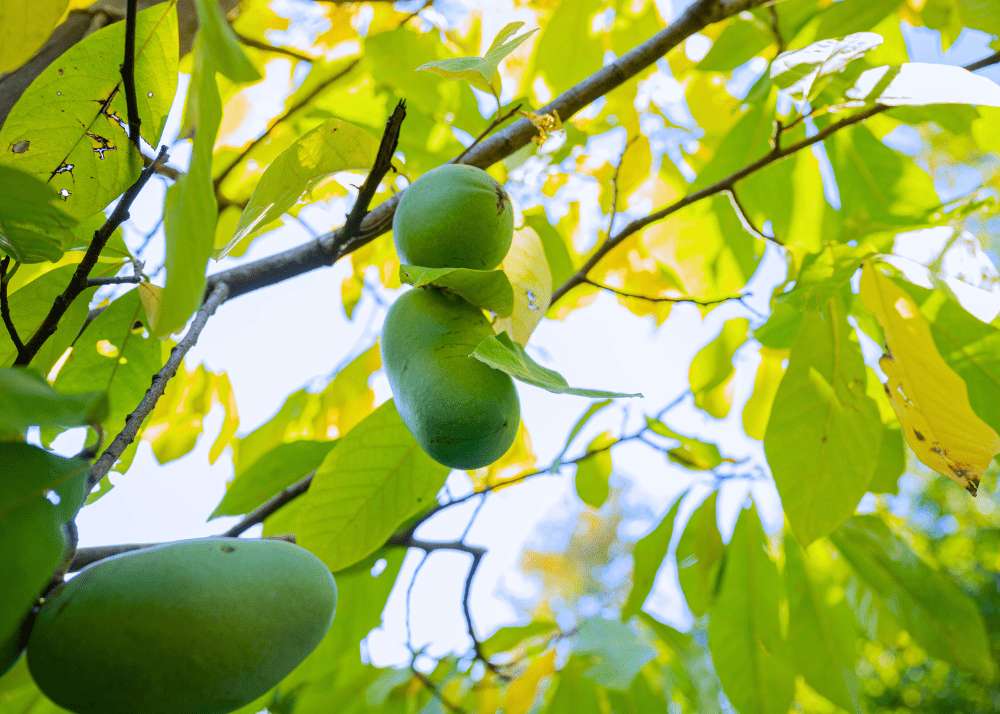Hey there, fellow native plant enthusiasts! Today, we’re diving into the wonderful world of Texas plants that not only add beauty to your yard but also offer delicious fruits and berries. These native, edible treasures are perfect for homeowners who want to grow their own tasty treats right in their backyard. So, let’s get started with 10 great native plant picks for San Antonio and surrounding area, along with and some basic tips on how to care for them!

(Paw Paw fruit)
10 Texas Native Edible Plants
- Texas Persimmon (Diospyros texana)
- Flavor & Use: These small, black fruits are sweet and great for fresh eating or making jams.
- Care Tips: They thrive in well-drained soil and full sun. No special care needed, just some occasional watering during dry spells.
- Pollination: Self-pollinating, so no need for a buddy tree!
- Mexican Plum (Prunus mexicana)
- Flavor & Use: The tart plums are perfect for jellies and wines.
- Care Tips: They prefer full sun to partial shade and well-drained soil. They can tolerate drought once established.
- Pollination: Self-pollinating, but planting more than one can increase yield.
- Agarita (Mahonia trifoliolata)
- Flavor & Use: These red berries are tart and can be made into jelly or wine.
- Care Tips: Very low maintenance! They do best in well-drained soil and full sun.
- Pollination: These shrubs are self-pollinating.
- Western Mayhaw (Crataegus opaca)
- Flavor & Use: The small, tart fruits are commonly used in jellies.
- Care Tips: They prefer wet, acidic soils and can handle occasional flooding. Full sun to partial shade works best.
- Pollination: Cross-pollination with another mayhaw variety can improve fruit set.
- Pawpaw (Asimina triloba)
- Flavor & Use: Known for its custard-like texture and tropical flavor, perfect for fresh eating or desserts.
- Care Tips: Needs rich, well-drained soil and a bit of shade. Water regularly, especially in dry periods.
- Pollination: Requires a cross-pollinator for fruit production.
- Texas Red Mulberry (Morus rubra) not currently available at Rainbow Gardens
- Flavor & Use: These sweet berries are great for fresh eating, jams, or even wine.
- Care Tips: Thrives in moist, well-drained soil and full sun to partial shade.
- Pollination: Self-pollinating, but having more trees can boost your berry bounty.
- Wild Blackberry (Rubus spp.) not currently available at Rainbow Gardens
- Flavor & Use: Juicy and sweet, perfect for pies, jams, or snacking.
- Care Tips: They prefer well-drained, slightly acidic soil and full sun. Regular pruning helps maintain their shape and productivity.
- Pollination: Self-pollinating, but yields improve with cross-pollination.
- Elderberry (Feature picture, Sambucus canadensis)
- Flavor & Use: These berries are excellent for syrups, wines, and medicinal uses.
- Care Tips: They like moist, well-drained soil and full sun to partial shade. Water regularly during dry spells.
- Pollination: Cross-pollination with another elderberry plant is needed for best fruit set.
- Prickly Pear (Opuntia engelmannii)
- Flavor & Use: The pads (nopales) and fruits (tunas) are edible, with the fruits being used in jellies and drinks.
- Care Tips: Extremely drought-tolerant and thrive in full sun and well-drained, sandy soil.
- Pollination: Self-pollinating, but having more plants can enhance fruit production.
- Passionflower (Passiflora incarnata)
- Flavor & Use: The fruit, known as maypop, is sweet and can be eaten fresh or used in desserts.
- Care Tips: They prefer well-drained soil and full sun. Regular watering is essential, especially during the growing season.
- Pollination: Needs cross-pollination for fruit set, so plant more than one!
There you have it, 10 native Texas plants that offer edible delights and are perfect for home gardens. Most of these plants are both cold hardy and heat tolerant, making them ideal for the Texas climate. With a bit of care and attention, you can enjoy a bountiful harvest right from your own yard. Fall is the bet time for planting trees and shrubs, natives included, so come see what we’ve got. Happy gardening!
~The Happy Gardener, Lisa Mulroy

